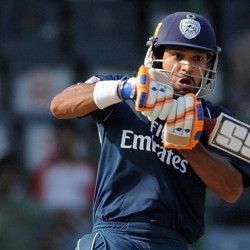
Shikhar Dhawan: The debutant demolishes Australia
The Indian selectors were probably holding Shikhar Dhawan back, so they could put him into the mix at the right time — like an army would withhold a secret weapon so as to unleash it when it is likely to inflict maximum damage. How else can we explain that a batsman, who has been playing for almost a decade, could come into the Indian side and play an innings that will be certainly rated as one of the best this year. Where were they hiding him all this time?

File Photo of Shikhar Dhawan, who scored an impressive century on his Test debut against Australia (Getty Images).
We know, of course, that no one could have foretold or even expected the Delhi left-hander to have played the way he did. But his stroke-play was so divine that there must have been strong evidence of his capabilities long before he was finally selected. No debutant before him had scored a faster Test hundred and there can’t have been many that played with such complete command.
He had me from his first boundary – an exquisite drive through the covers with the follow through halted early, showing the full face of the blade, and with right elbow pointed skyward. He would return to the cover area countless times throughout this remarkable innings, and generally played through the offside in a manner that could scarcely have been bettered by Sourav Ganguly.
Dhawan was so dominant piercing the offside that one wondered if the Australians would not have done themselves a huge favour by trying to force him to score through the leg-side. But the debutant was so impressive; his authority so complete, that any attempt to restrain him might have been futile. He found the gaps with ease and regularity; his balance was outstanding; his footwork certain and graceful. The visitors must have been shocked that a man playing in his first Test could conceive of, much less execute such an outstanding innings. His 50 came at a run-a-ball; his hundred required 85; and his eventual 187 was made off 174 deliveries and contained a stunning 33 fours and two sixes.
It was as if Dhawan decided that he would not be contained under any circumstances. When Clarke removed himself from slip the opener unsheathed the reverse-sweep, going past the newly untenanted area for a boundary. Two consecutive hits down the leg-side, past the keeper with an almost vertical bat defied description, and two former great Test cricketers doing commentary delved deep to come up with an appropriate name for the stroke. They eventually settled on “reverse leg drive.” Or something like that.
Perhaps the most impressive thing about Dhawan’s innings was that he never lifted the ball off the ground until after he was past his century. All of his strokes hugged the turf; few went within the grasp of the fielders, and as he rattled along at a Sehwag-like rate of scoring he must have considered how easy this Test-match-batting-thing is.
Meanwhile, his opening partner Murali Vijay was racking up an impressive innings of his own. He was not as lordly and as assertive as Dhawan, and willingly ceded centre-stage to his junior partner. But the Hyderabad century-maker was untroubled and looked like he could stay in the middle for as long as he wanted. Their partnership was worth 289 before Dhawan fell to a tame catch at silly point off Lyon.
As his career advances, Dhawan will undoubtedly face much stiffer conditions and he will have to grapple with more incisive bowling attacks. If he finds himself not being able to rule the stage the way he on the third day of the Mohali Test against the Australians, he should realize that his batting on the day was close to being of the highest standard possible. If he manages to bat like that again – great. But if he does not, then he should be proud to know that he played one of the best innings that anyone could ever wish to see.